Install Python modules
To run this vignette you need to install all the necessary Python modules.
This can be done manually, see https://rubd.github.io/Giotto_site/articles/installation_issues.html#python-manual-installation
This can be done within R using our installation tools (installGiottoEnvironment), see https://rubd.github.io/Giotto_site/articles/tut0_giotto_environment.html for more information.
(optional) set giotto instructions
# to automatically save figures in save_dir set save_plot to TRUE temp_dir = getwd() temp_dir = '~/Temp/' myinstructions = createGiottoInstructions(save_dir = temp_dir, save_plot = TRUE, show_plot = FALSE)
1. Create a Giotto object
minimum requirements:
- matrix with expression information (or path to)
- x,y(,z) coordinates for cells or spots (or path to)
# giotto object expr_path = system.file("extdata", "seqfish_field_expr.txt", package = 'Giotto') loc_path = system.file("extdata", "seqfish_field_locs.txt", package = 'Giotto') seqfish_mini <- createGiottoObject(raw_exprs = expr_path, spatial_locs = loc_path, instructions = myinstructions)
How to work with Giotto instructions that are part of your Giotto object:
- show the instructions associated with your Giotto object with showGiottoInstructions
- change one or more instructions with changeGiottoInstructions
- replace all instructions at once with replaceGiottoInstructions
- read or get a specific giotto instruction with readGiottoInstructions
Of note, the python path can only be set once in an R session. See the reticulate package for more information.
# show instructions associated with giotto object (seqfish_mini) showGiottoInstructions(seqfish_mini)
2. processing steps
- filter genes and cells based on detection frequencies
- normalize expression matrix (log transformation, scaling factor and/or z-scores)
- add cell and gene statistics (optional)
- adjust expression matrix for technical covariates or batches (optional). These results will be stored in the custom slot.
seqfish_mini <- filterGiotto(gobject = seqfish_mini, expression_threshold = 0.5, gene_det_in_min_cells = 20, min_det_genes_per_cell = 0) seqfish_mini <- normalizeGiotto(gobject = seqfish_mini, scalefactor = 6000, verbose = T) seqfish_mini <- addStatistics(gobject = seqfish_mini) seqfish_mini <- adjustGiottoMatrix(gobject = seqfish_mini, expression_values = c('normalized'), covariate_columns = c('nr_genes', 'total_expr'))
3. dimension reduction
- identify highly variable genes (HVG)
- perform PCA
- identify number of significant prinicipal components (PCs)
- run UMAP and/or TSNE on PCs (or directly on matrix)
seqfish_mini <- calculateHVG(gobject = seqfish_mini)
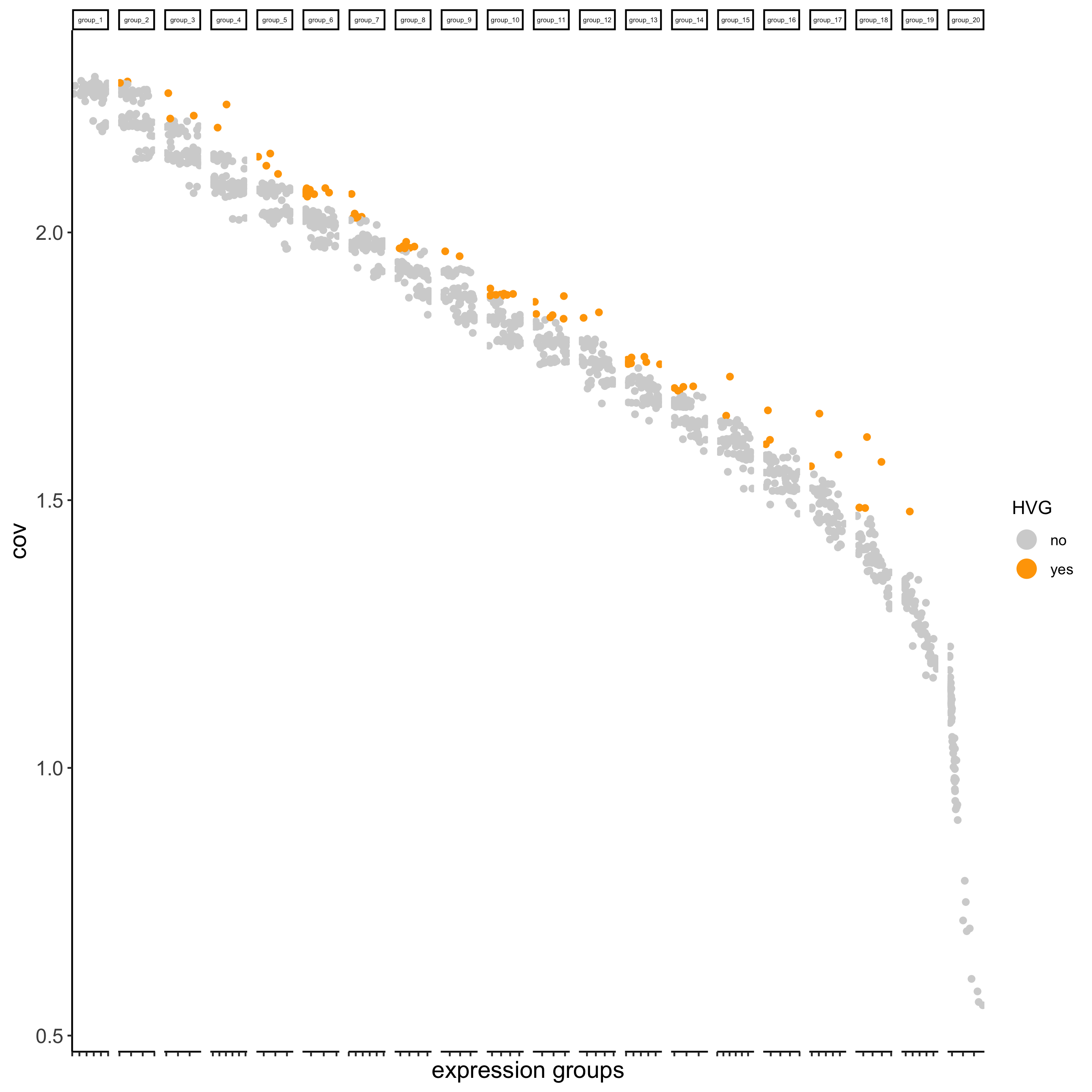
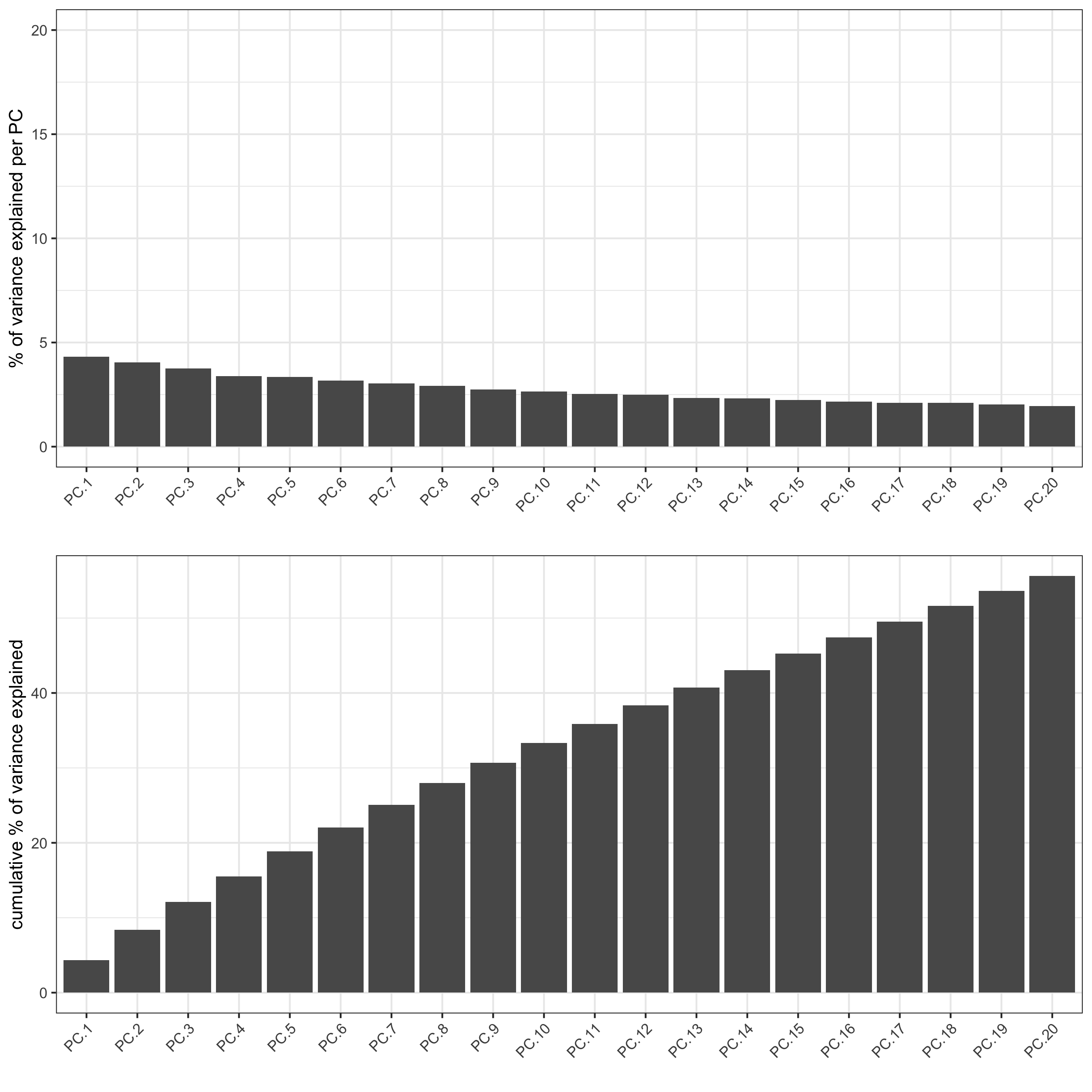
jackstrawPlot(seqfish_mini, ncp = 20)
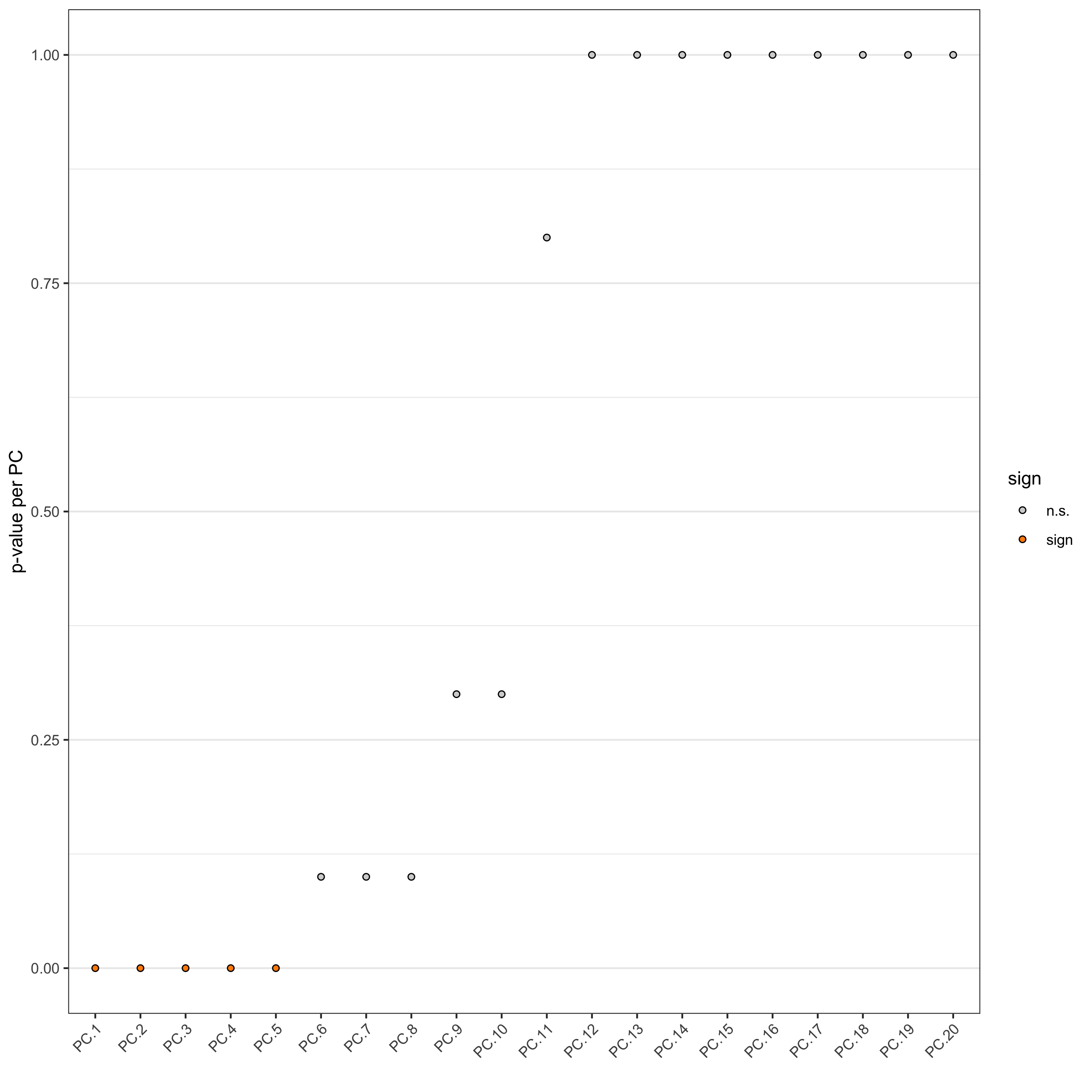
plotPCA(seqfish_mini)
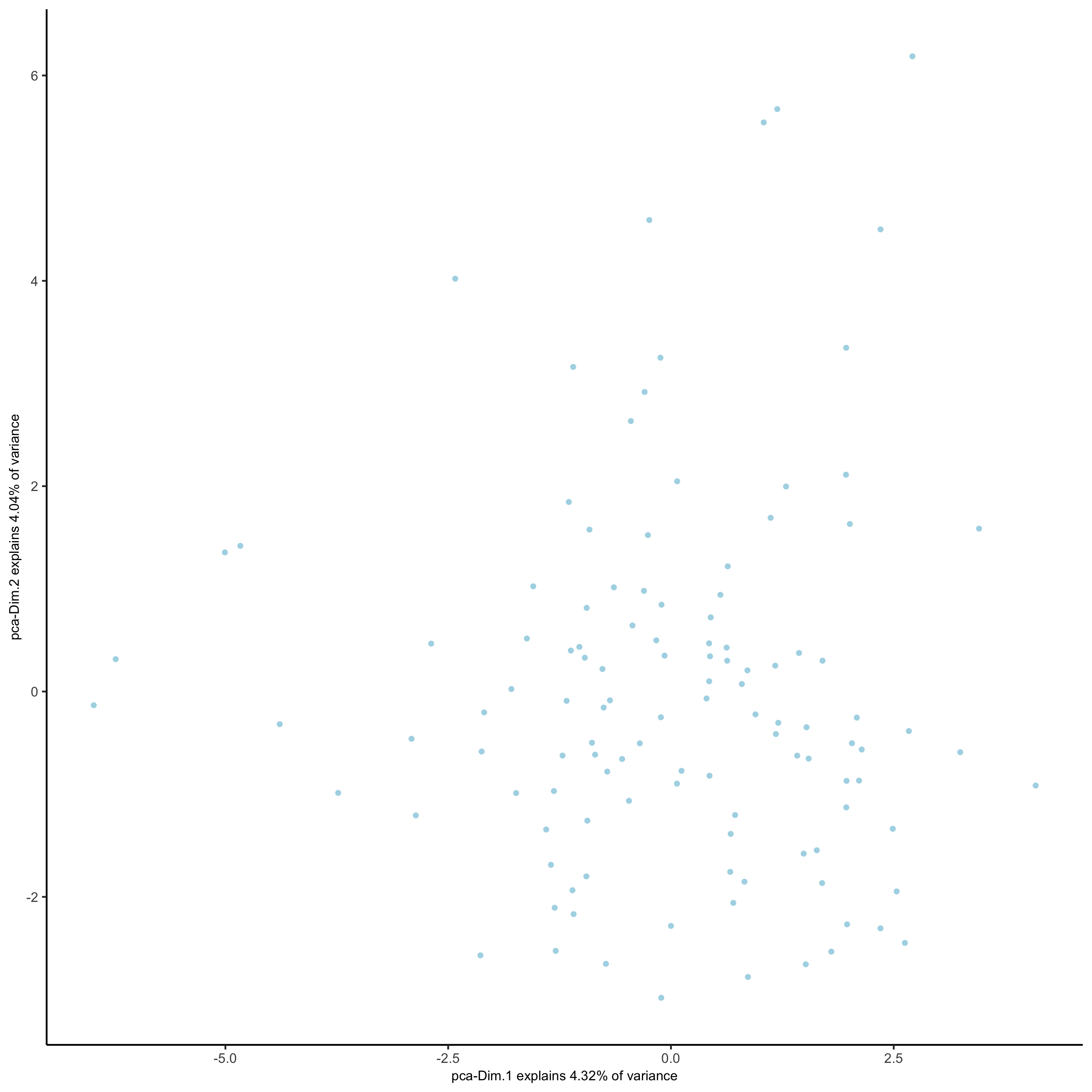
seqfish_mini <- runUMAP(seqfish_mini, dimensions_to_use = 1:5, n_threads = 2) plotUMAP(gobject = seqfish_mini)
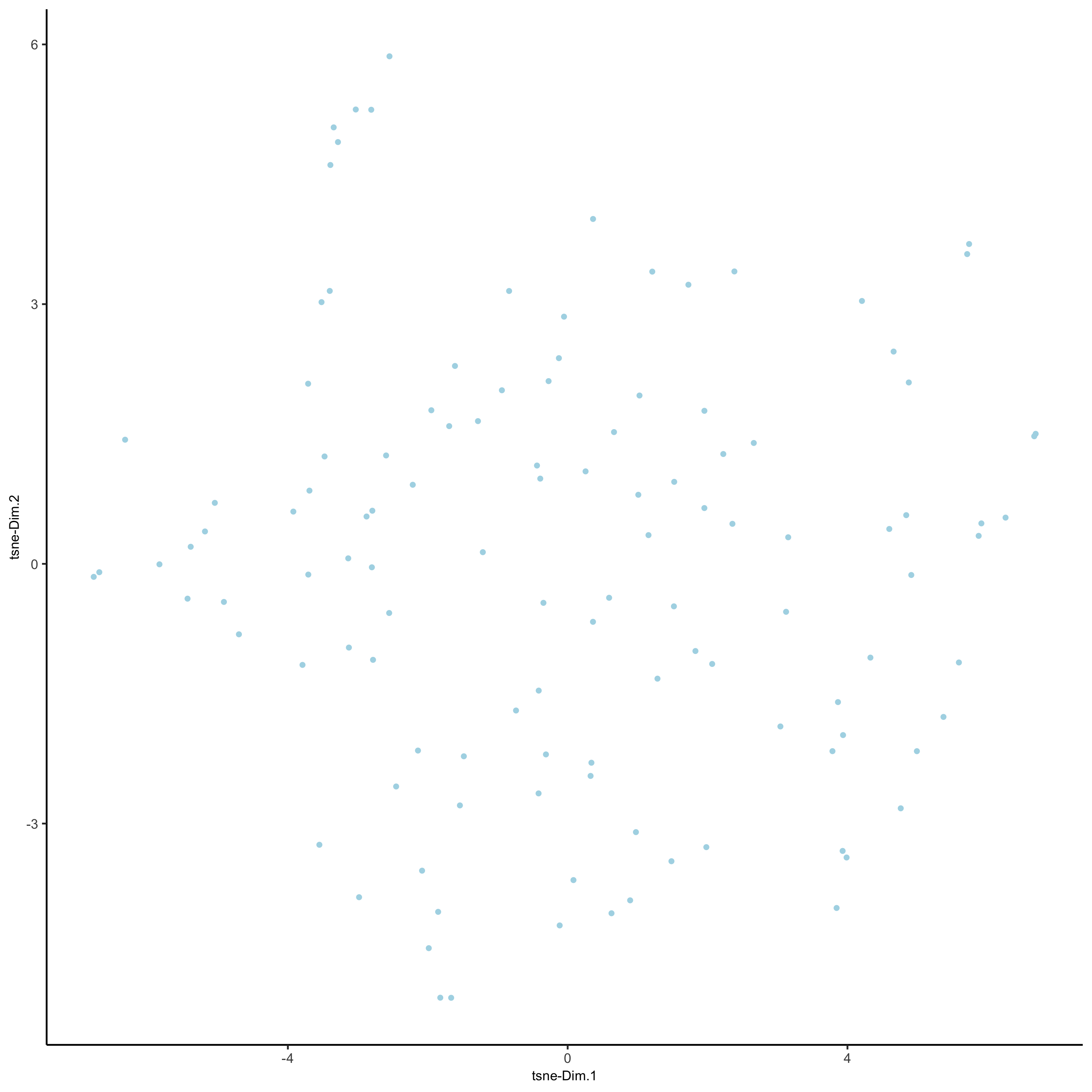
4. clustering
- create a shared (default) nearest network in PCA space (or directly on matrix)
- cluster on nearest network with Leiden or Louvan (kmeans and hclust are alternatives)
seqfish_mini <- createNearestNetwork(gobject = seqfish_mini, dimensions_to_use = 1:5, k = 5) seqfish_mini <- doLeidenCluster(gobject = seqfish_mini, resolution = 0.4, n_iterations = 1000) # visualize UMAP cluster results plotUMAP(gobject = seqfish_mini, cell_color = 'leiden_clus', show_NN_network = T, point_size = 2.5)
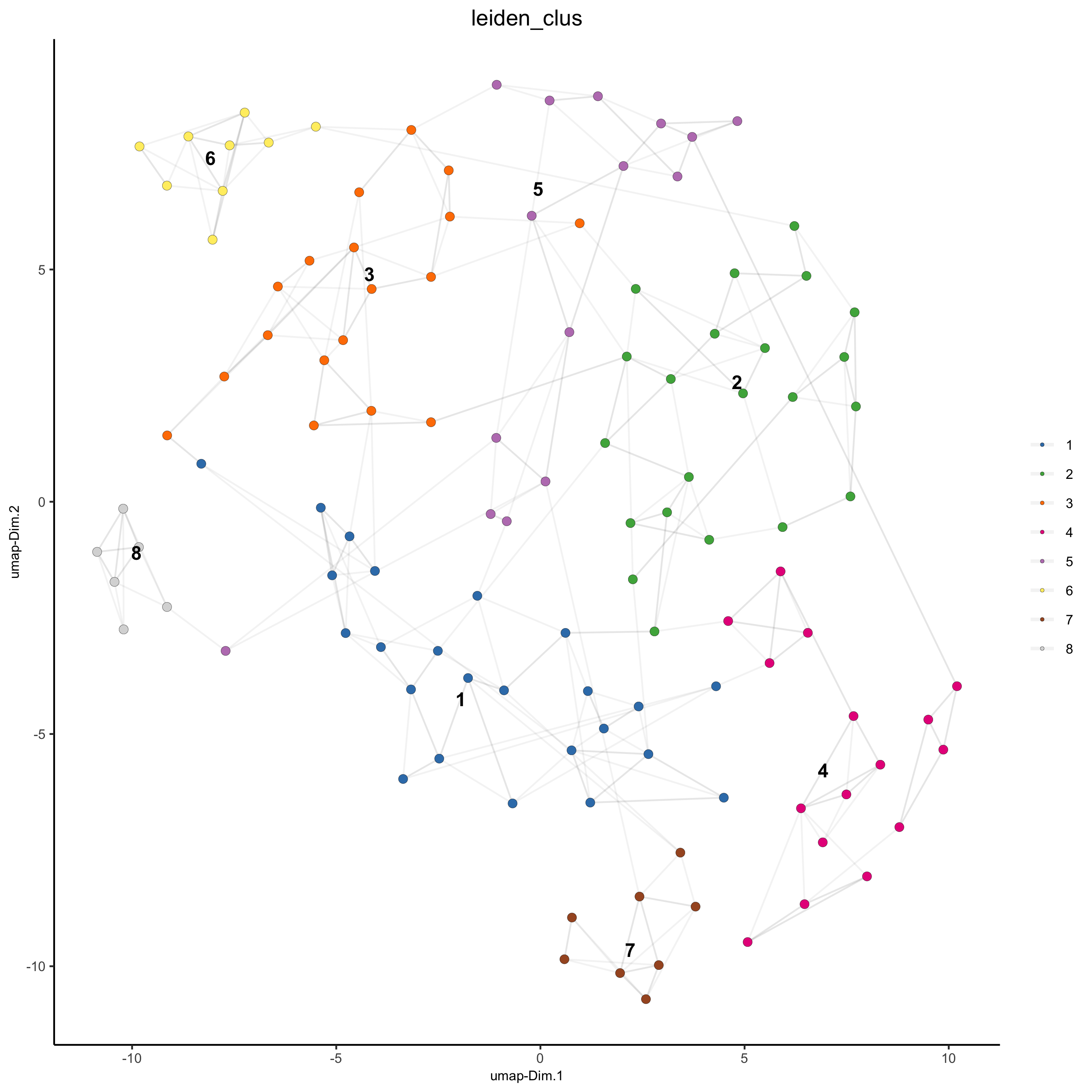
# visualize UMAP and spatial results spatDimPlot(gobject = seqfish_mini, cell_color = 'leiden_clus', spat_point_shape = 'voronoi') # heatmap and dendrogram showClusterHeatmap(gobject = seqfish_mini, cluster_column = 'leiden_clus')
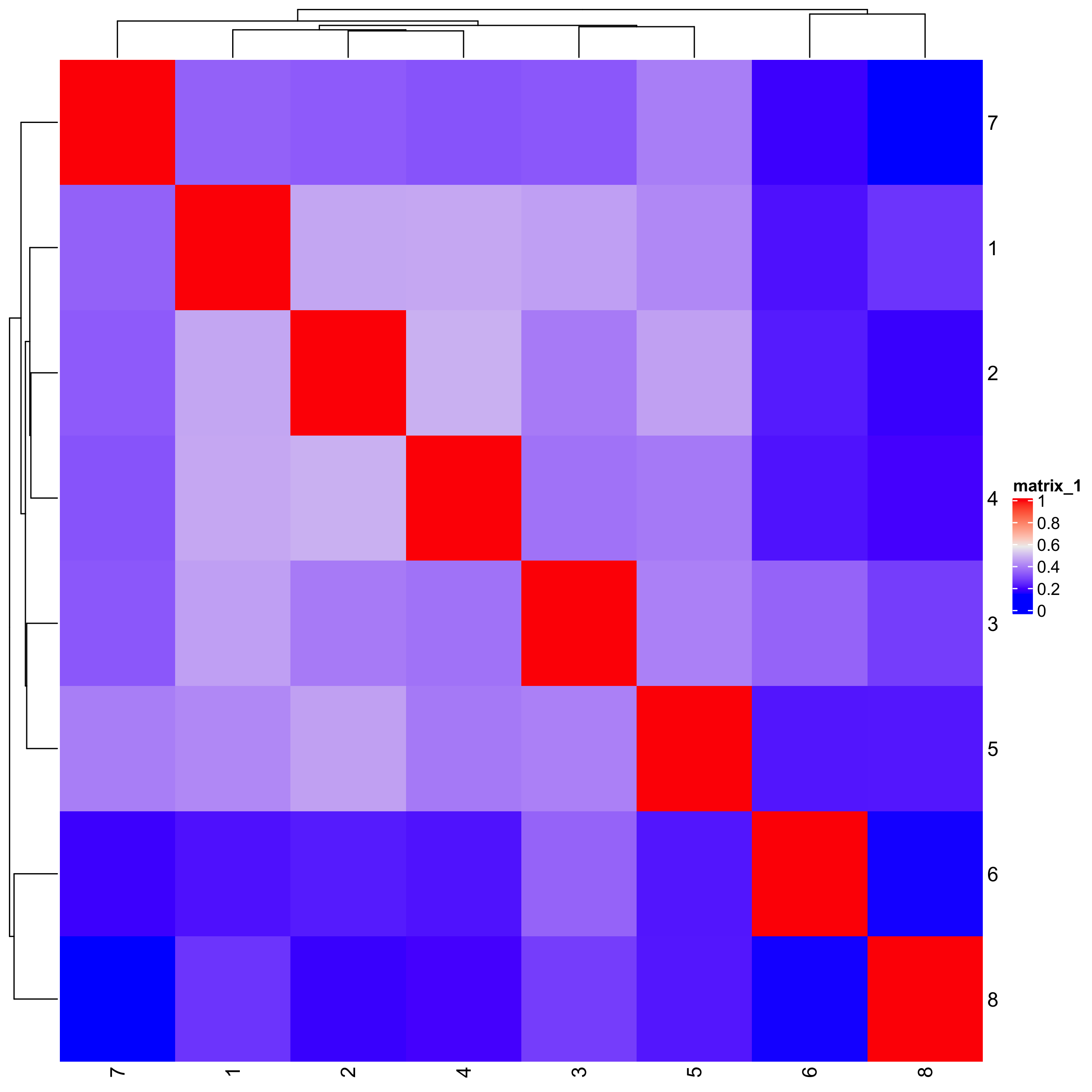
showClusterDendrogram(seqfish_mini, h = 0.5, rotate = T, cluster_column = 'leiden_clus')
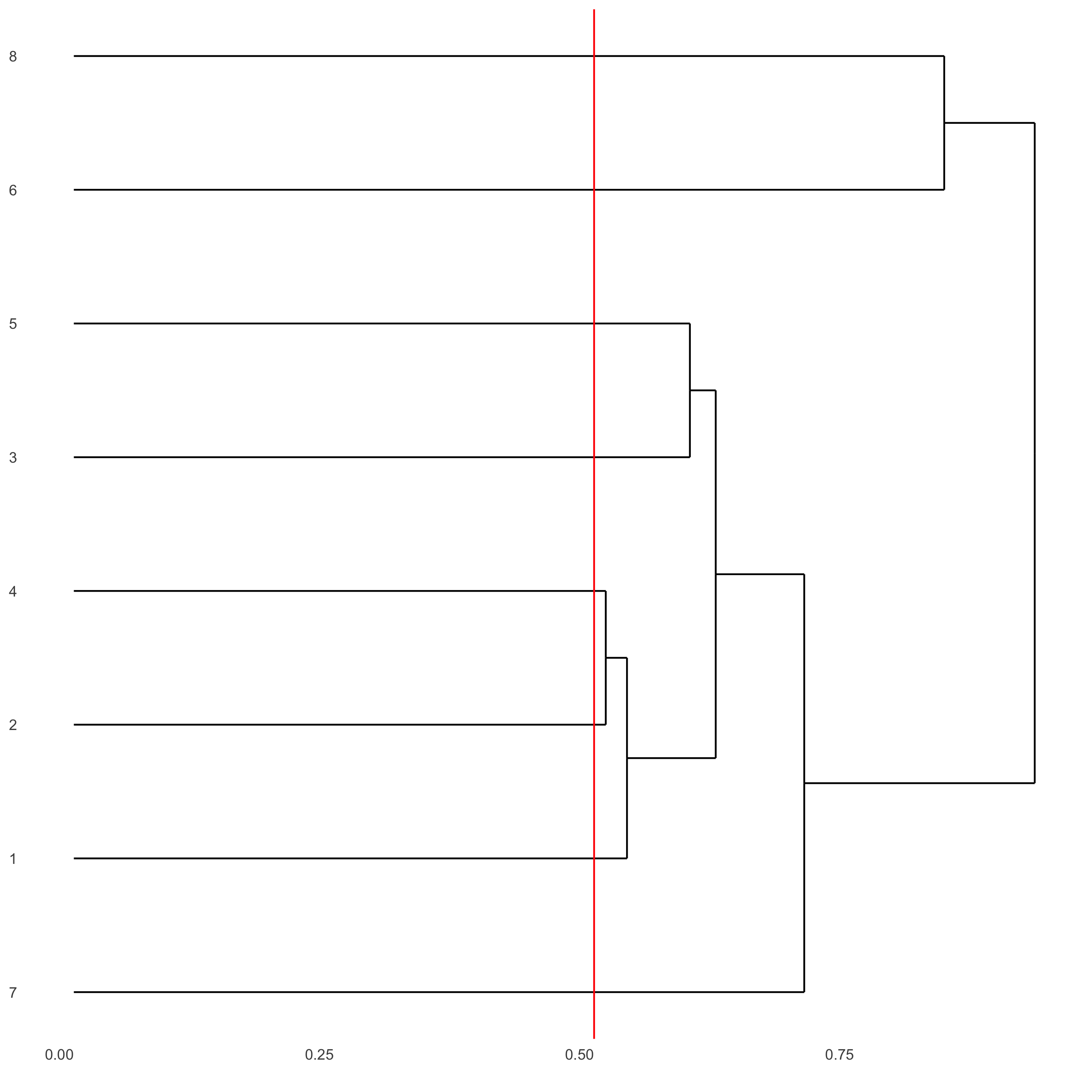
5. differential expression
gini_markers = findMarkers_one_vs_all(gobject = seqfish_mini, method = 'gini', expression_values = 'normalized', cluster_column = 'leiden_clus', min_genes = 20, min_expr_gini_score = 0.5, min_det_gini_score = 0.5) # get top 2 genes per cluster and visualize with violinplot topgenes_gini = gini_markers[, head(.SD, 2), by = 'cluster'] violinPlot(seqfish_mini, genes = topgenes_gini$genes, cluster_column = 'leiden_clus')
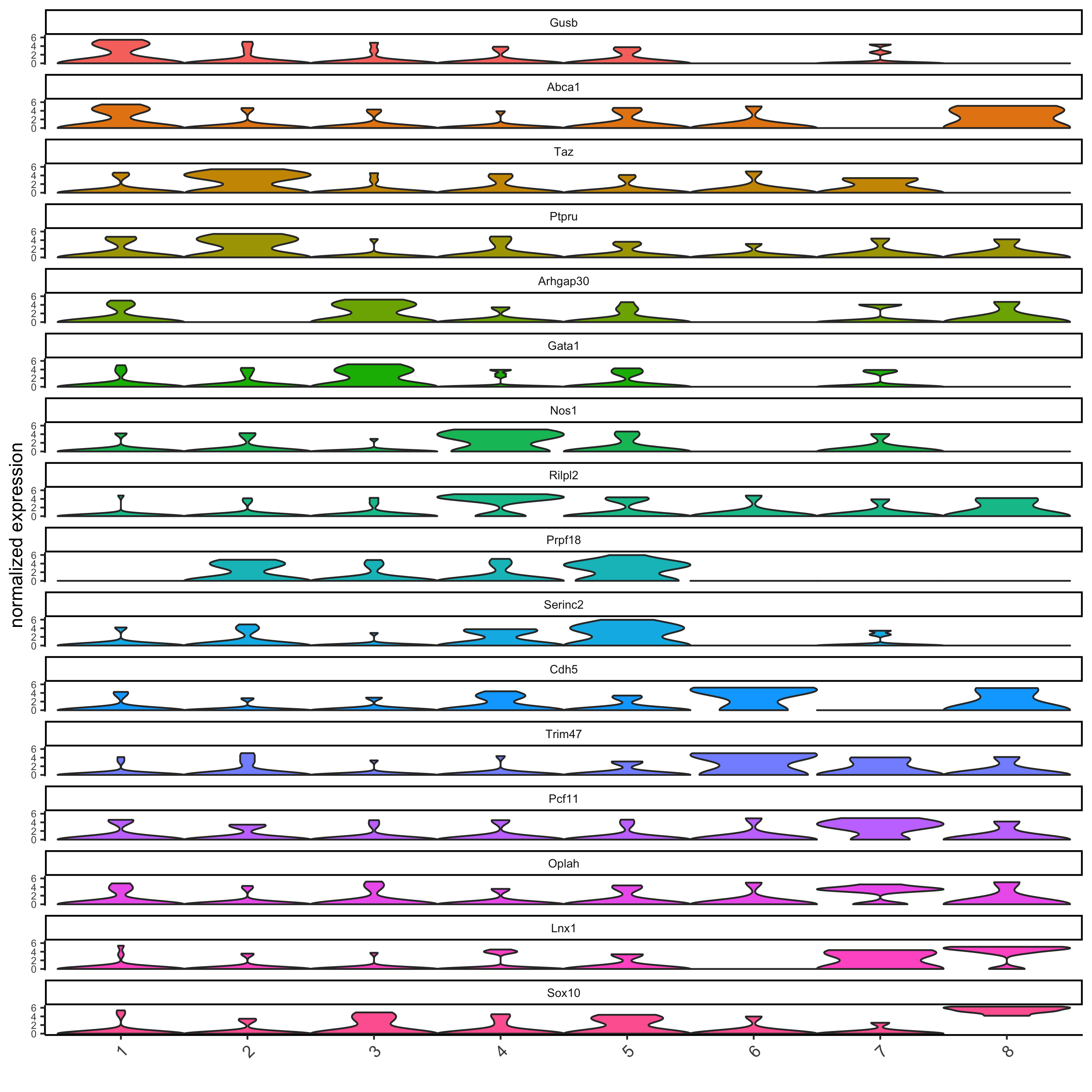
# get top 6 genes per cluster and visualize with heatmap topgenes_gini2 = gini_markers[, head(.SD, 6), by = 'cluster'] plotMetaDataHeatmap(seqfish_mini, selected_genes = topgenes_gini2$genes, metadata_cols = c('leiden_clus'))

6. cell type annotation
clusters_cell_types = c('cell A', 'cell B', 'cell C', 'cell D', 'cell E', 'cell F', 'cell G') names(clusters_cell_types) = 1:7 seqfish_mini = annotateGiotto(gobject = seqfish_mini, annotation_vector = clusters_cell_types, cluster_column = 'leiden_clus', name = 'cell_types') # check new cell metadata pDataDT(seqfish_mini) # visualize annotations spatDimPlot(gobject = seqfish_mini, cell_color = 'cell_types', spat_point_size = 3, dim_point_size = 3)
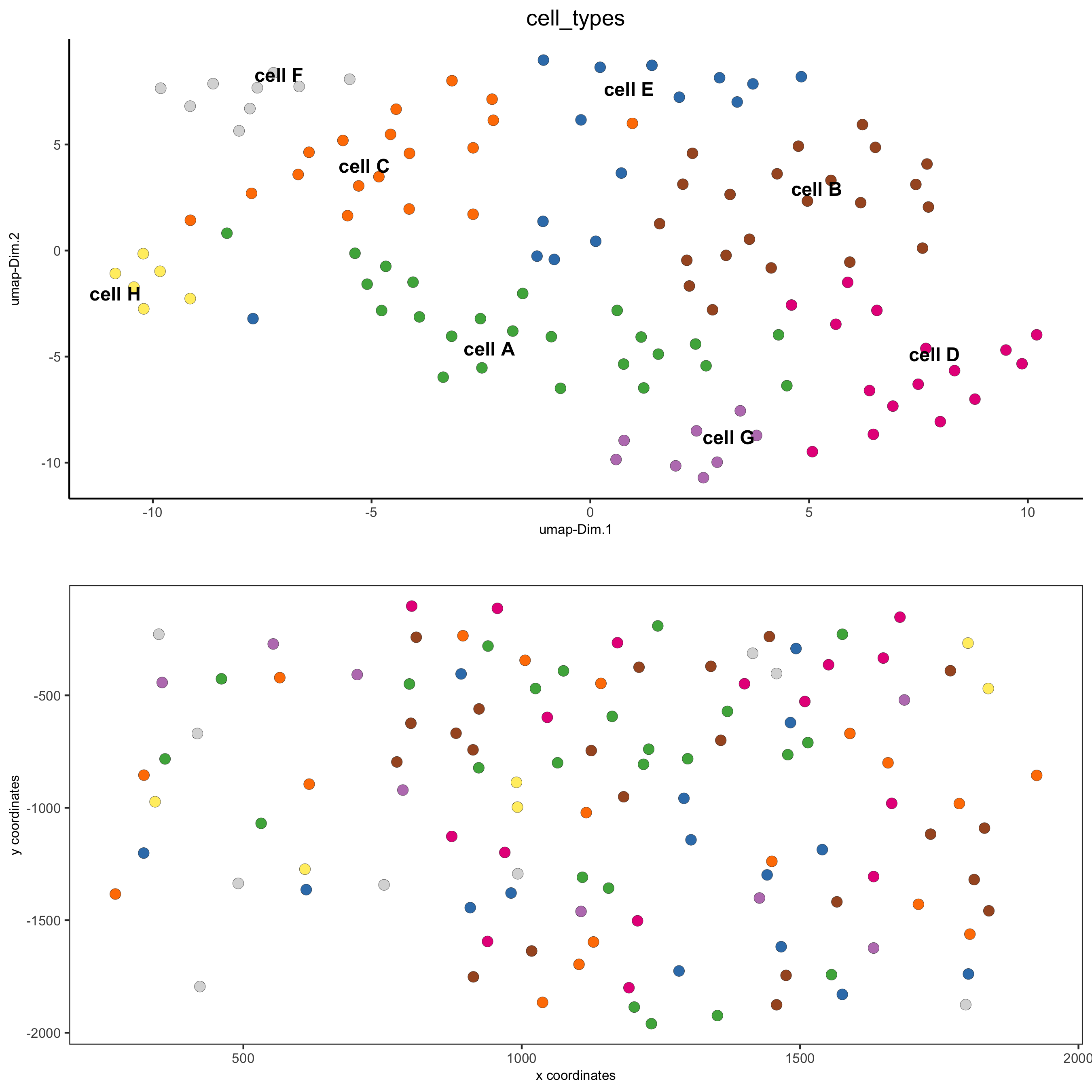
7. spatial grid
Create a grid based on defined stepsizes in the x,y(,z) axes.
seqfish_mini <- createSpatialGrid(gobject = seqfish_mini, sdimx_stepsize = 300, sdimy_stepsize = 300, minimum_padding = 50) showGrids(seqfish_mini) # visualize grid spatPlot(gobject = seqfish_mini, show_grid = T, point_size = 1.5)
8. spatial network
- visualize information about the default Delaunay network
- create a spatial Delaunay network (default)
- create a spatial kNN network
plotStatDelaunayNetwork(gobject = seqfish_mini, maximum_distance = 400) seqfish_mini = createSpatialNetwork(gobject = seqfish_mini, minimum_k = 2, maximum_distance_delaunay = 400) seqfish_mini = createSpatialNetwork(gobject = seqfish_mini, minimum_k = 2, method = 'kNN', k = 10) showNetworks(seqfish_mini) # visualize the two different spatial networks spatPlot(gobject = seqfish_mini, show_network = T, network_color = 'blue', spatial_network_name = 'Delaunay_network', point_size = 2.5, cell_color = 'leiden_clus') spatPlot(gobject = seqfish_mini, show_network = T, network_color = 'blue', spatial_network_name = 'kNN_network', point_size = 2.5, cell_color = 'leiden_clus')
9. spatial genes
Identify spatial genes with 3 different methods:
- binSpect with kmeans binarization (default)
- binSpect with rank binarization
- silhouetteRank
Visualize top 4 genes per method.
km_spatialgenes = binSpect(seqfish_mini) spatGenePlot(seqfish_mini, expression_values = 'scaled', genes = km_spatialgenes[1:4]$genes, point_shape = 'border', point_border_stroke = 0.1, show_network = F, network_color = 'lightgrey', point_size = 2.5, cow_n_col = 2) rank_spatialgenes = binSpect(seqfish_mini, bin_method = 'rank') spatGenePlot(seqfish_mini, expression_values = 'scaled', genes = rank_spatialgenes[1:4]$genes, point_shape = 'border', point_border_stroke = 0.1, show_network = F, network_color = 'lightgrey', point_size = 2.5, cow_n_col = 2)
silh_spatialgenes = silhouetteRank(gobject = seqfish_mini) # TODO: suppress print output spatGenePlot(seqfish_mini, expression_values = 'scaled', genes = silh_spatialgenes[1:4]$genes, point_shape = 'border', point_border_stroke = 0.1, show_network = F, network_color = 'lightgrey', point_size = 2.5, cow_n_col = 2)
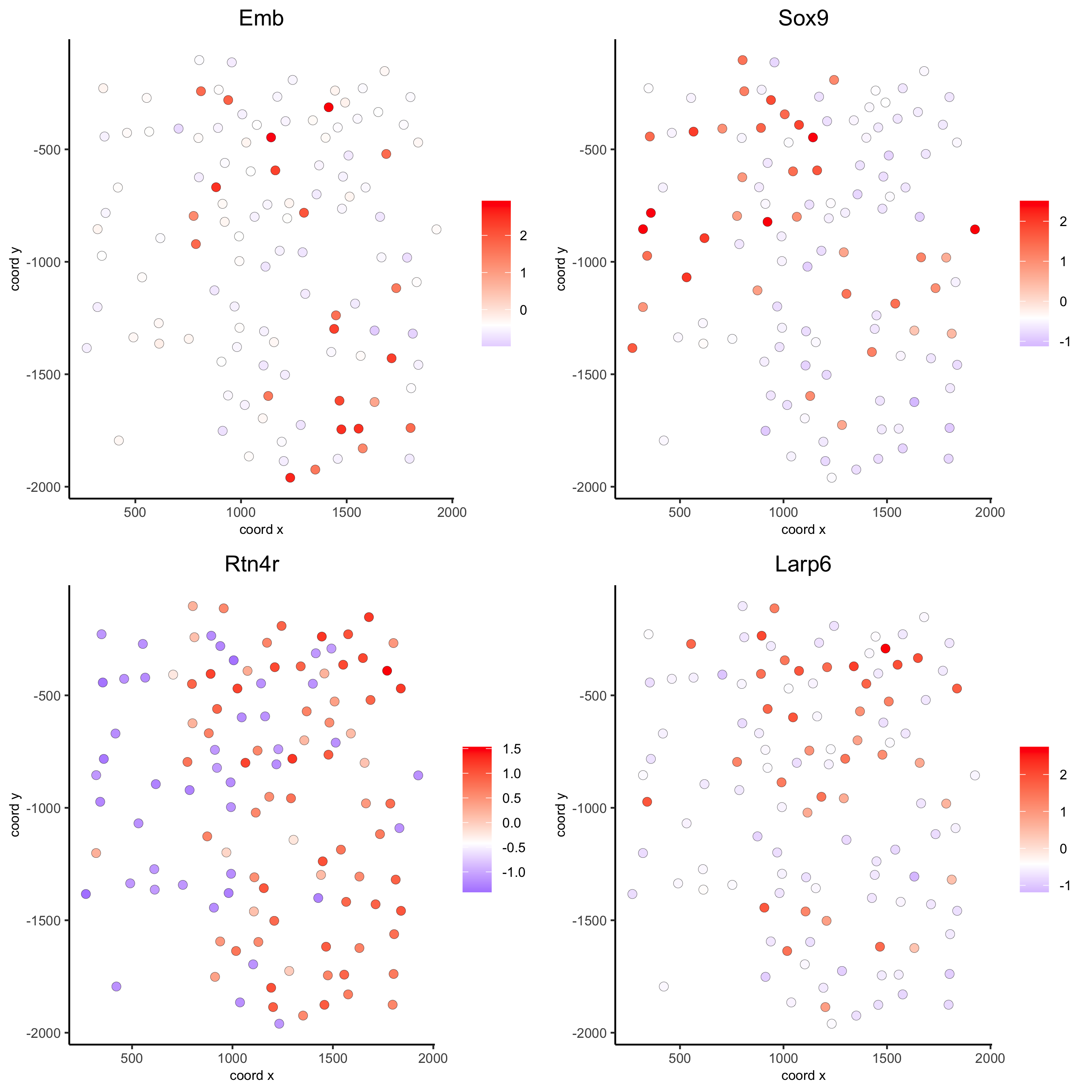
10. spatial co-expression patterns
Identify robust spatial co-expression patterns using the spatial network or grid and a subset of individual spatial genes.
1. calculate spatial correlation scores
2. cluster correlation scores
# 1. calculate spatial correlation scores ext_spatial_genes = km_spatialgenes[1:500]$genes spat_cor_netw_DT = detectSpatialCorGenes(seqfish_mini, method = 'network', spatial_network_name = 'Delaunay_network', subset_genes = ext_spatial_genes) # 2. cluster correlation scores spat_cor_netw_DT = clusterSpatialCorGenes(spat_cor_netw_DT, name = 'spat_netw_clus', k = 8) heatmSpatialCorGenes(seqfish_mini, spatCorObject = spat_cor_netw_DT, use_clus_name = 'spat_netw_clus')
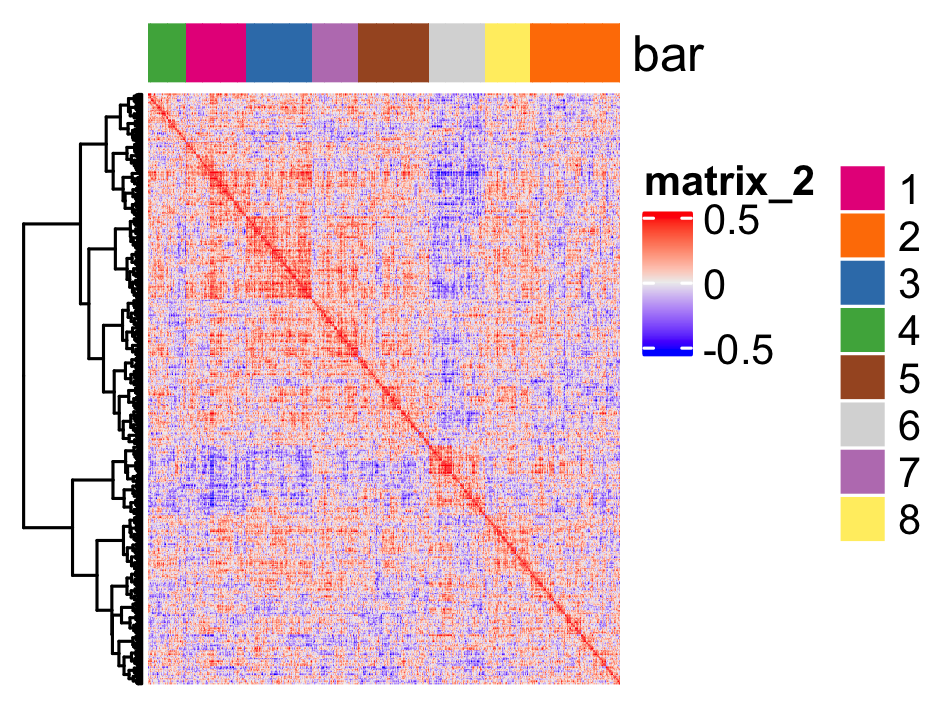
netw_ranks = rankSpatialCorGroups(seqfish_mini, spatCorObject = spat_cor_netw_DT, use_clus_name = 'spat_netw_clus') top_netw_spat_cluster = showSpatialCorGenes(spat_cor_netw_DT, use_clus_name = 'spat_netw_clus', selected_clusters = 6, show_top_genes = 1) cluster_genes_DT = showSpatialCorGenes(spat_cor_netw_DT, use_clus_name = 'spat_netw_clus', show_top_genes = 1) cluster_genes = cluster_genes_DT$clus; names(cluster_genes) = cluster_genes_DT$gene_ID seqfish_mini = createMetagenes(seqfish_mini, gene_clusters = cluster_genes, name = 'cluster_metagene') spatCellPlot(seqfish_mini, spat_enr_names = 'cluster_metagene', cell_annotation_values = netw_ranks$clusters, point_size = 1.5, cow_n_col = 3)
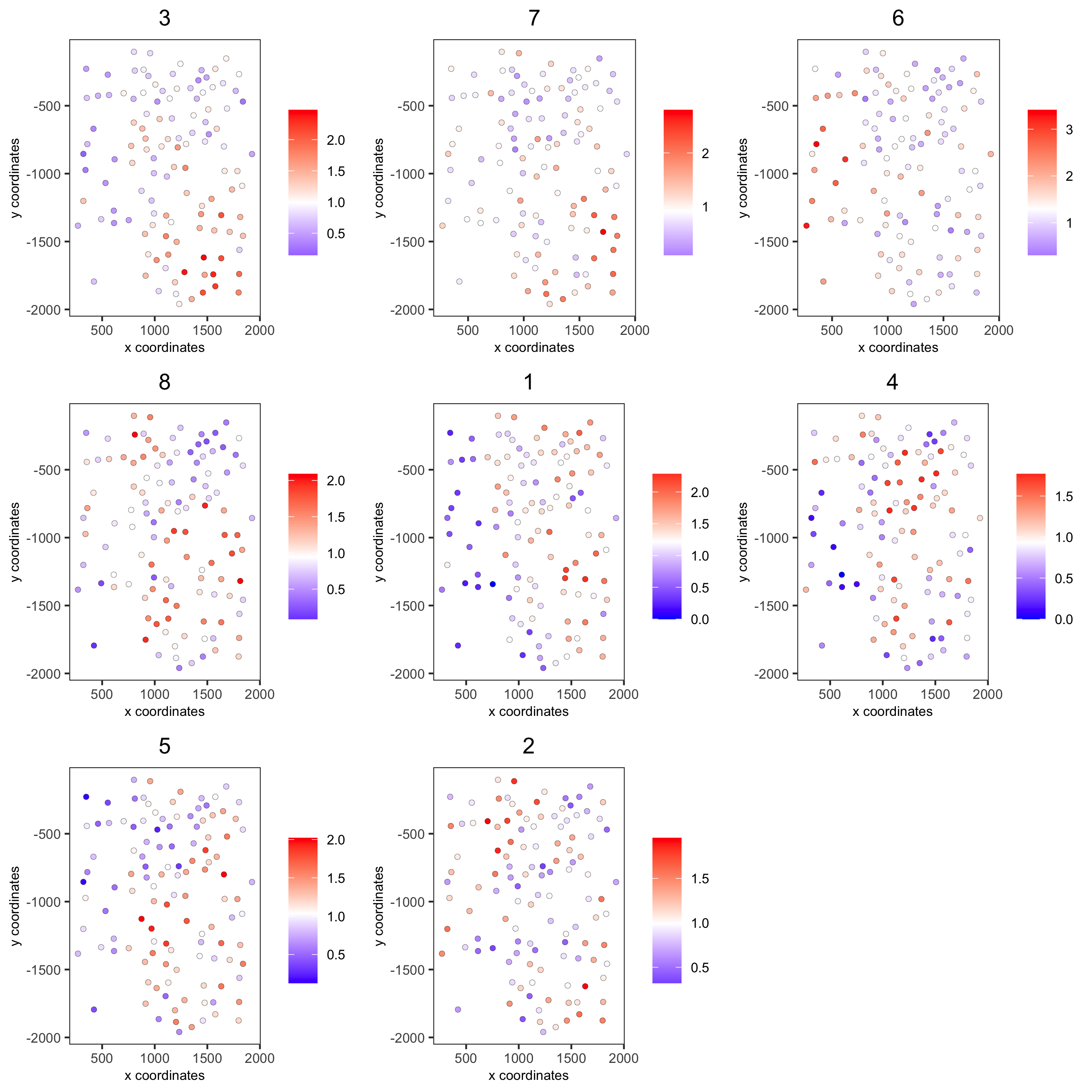
11. spatial HMRF domains
hmrf_folder = paste0(temp_dir,'/','11_HMRF/') if(!file.exists(hmrf_folder)) dir.create(hmrf_folder, recursive = T) # perform hmrf my_spatial_genes = km_spatialgenes[1:100]$genes HMRF_spatial_genes = doHMRF(gobject = seqfish_mini, expression_values = 'scaled', spatial_genes = my_spatial_genes, spatial_network_name = 'Delaunay_network', k = 9, betas = c(28,2,2), output_folder = paste0(hmrf_folder, '/', 'Spatial_genes/SG_top100_k9_scaled')) # check and select hmrf for(i in seq(28, 30, by = 2)) { viewHMRFresults2D(gobject = seqfish_mini, HMRFoutput = HMRF_spatial_genes, k = 9, betas_to_view = i, point_size = 2) } seqfish_mini = addHMRF(gobject = seqfish_mini, HMRFoutput = HMRF_spatial_genes, k = 9, betas_to_add = c(28), hmrf_name = 'HMRF') # visualize selected hmrf result giotto_colors = Giotto:::getDistinctColors(9) names(giotto_colors) = 1:9 spatPlot(gobject = seqfish_mini, cell_color = 'HMRF_k9_b.28', point_size = 3, coord_fix_ratio = 1, cell_color_code = giotto_colors)
12. cell neighborhood: cell-type/cell-type interactions
set.seed(seed = 2841) cell_proximities = cellProximityEnrichment(gobject = seqfish_mini, cluster_column = 'cell_types', spatial_network_name = 'Delaunay_network', adjust_method = 'fdr', number_of_simulations = 1000) # barplot cellProximityBarplot(gobject = seqfish_mini, CPscore = cell_proximities, min_orig_ints = 5, min_sim_ints = 5)
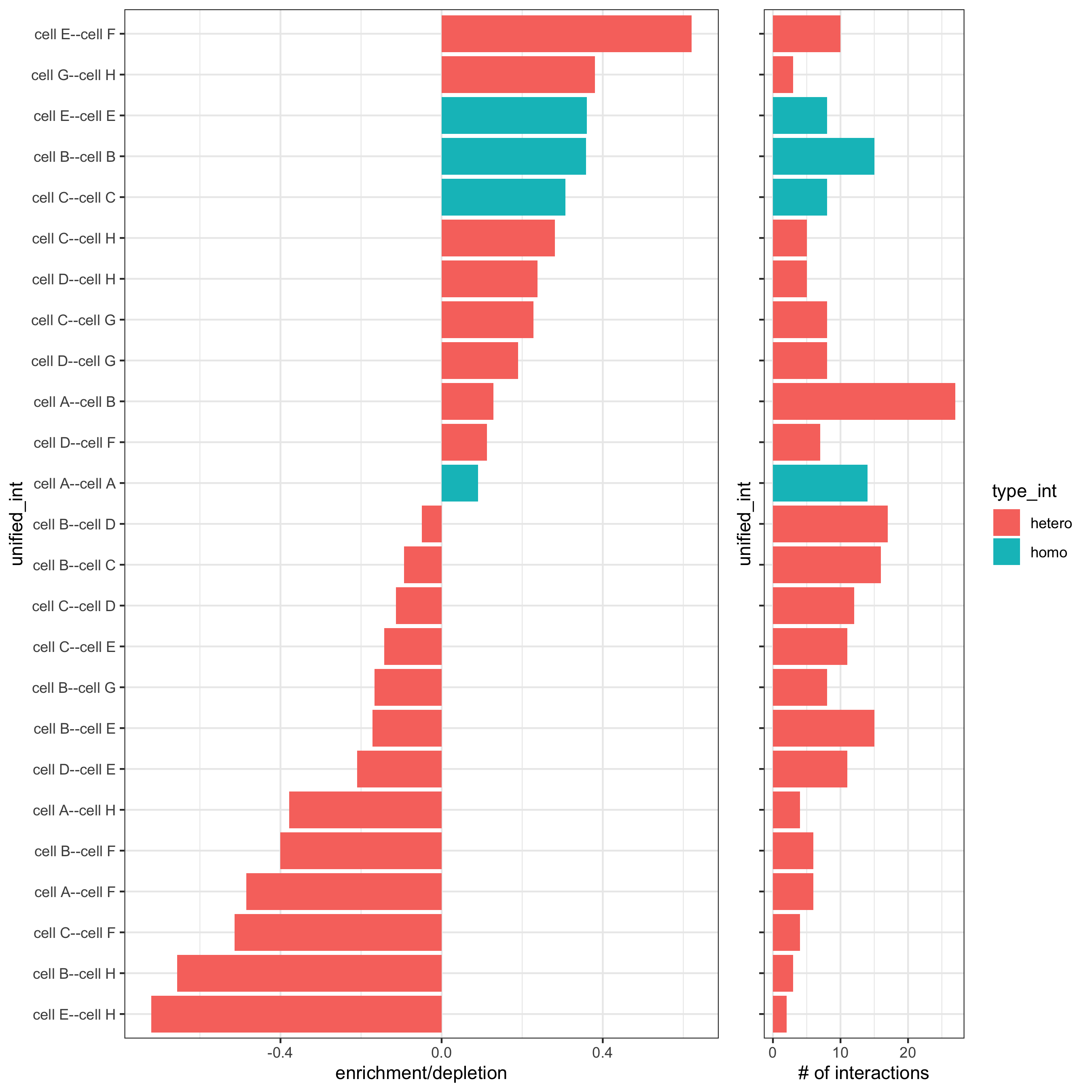
## heatmap cellProximityHeatmap(gobject = seqfish_mini, CPscore = cell_proximities, order_cell_types = T, scale = T, color_breaks = c(-1.5, 0, 1.5), color_names = c('blue', 'white', 'red'))

# network cellProximityNetwork(gobject = seqfish_mini, CPscore = cell_proximities, remove_self_edges = T, only_show_enrichment_edges = T)
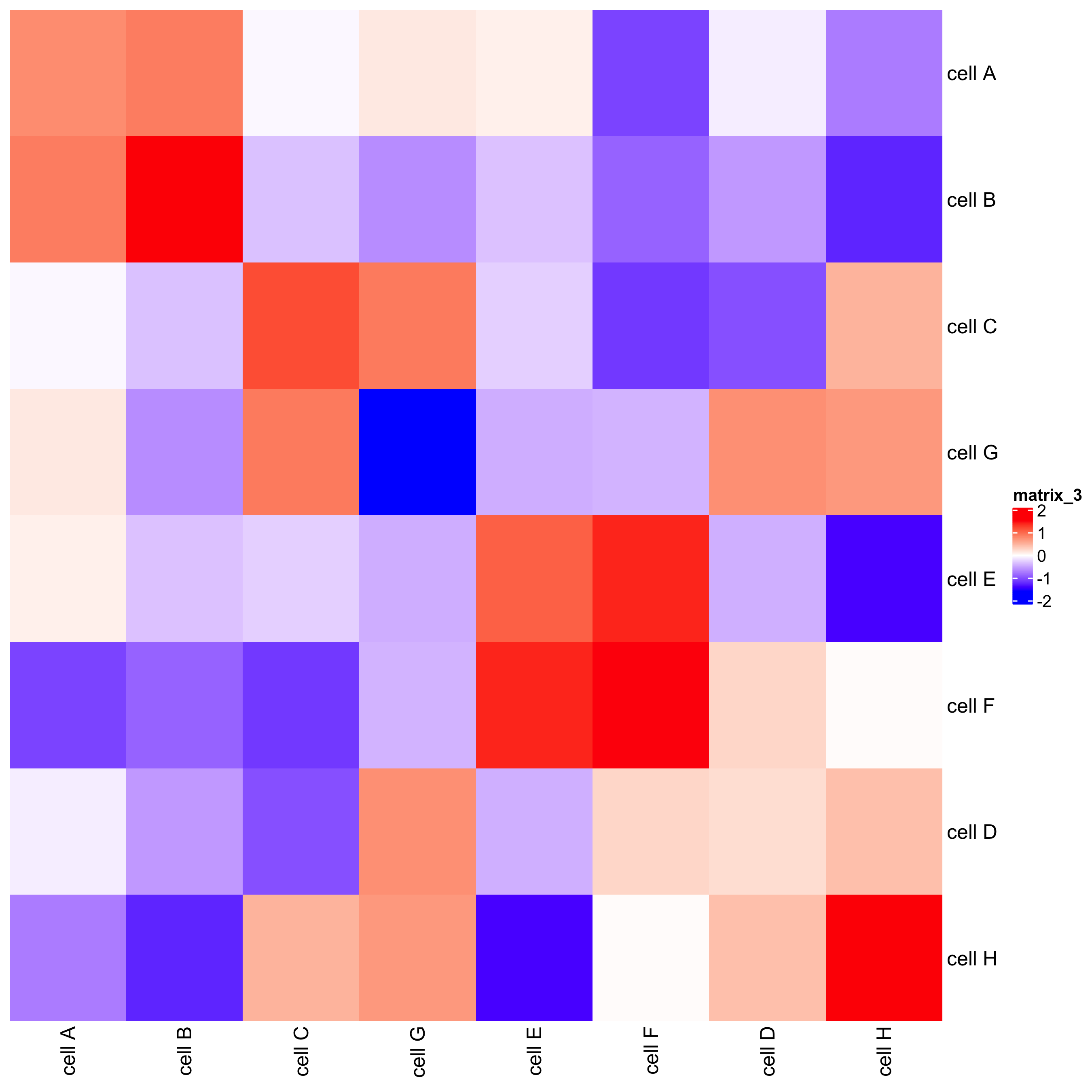
# network with self-edges cellProximityNetwork(gobject = seqfish_mini, CPscore = cell_proximities, remove_self_edges = F, self_loop_strength = 0.3, only_show_enrichment_edges = F, rescale_edge_weights = T, node_size = 8, edge_weight_range_depletion = c(1, 2), edge_weight_range_enrichment = c(2,5))
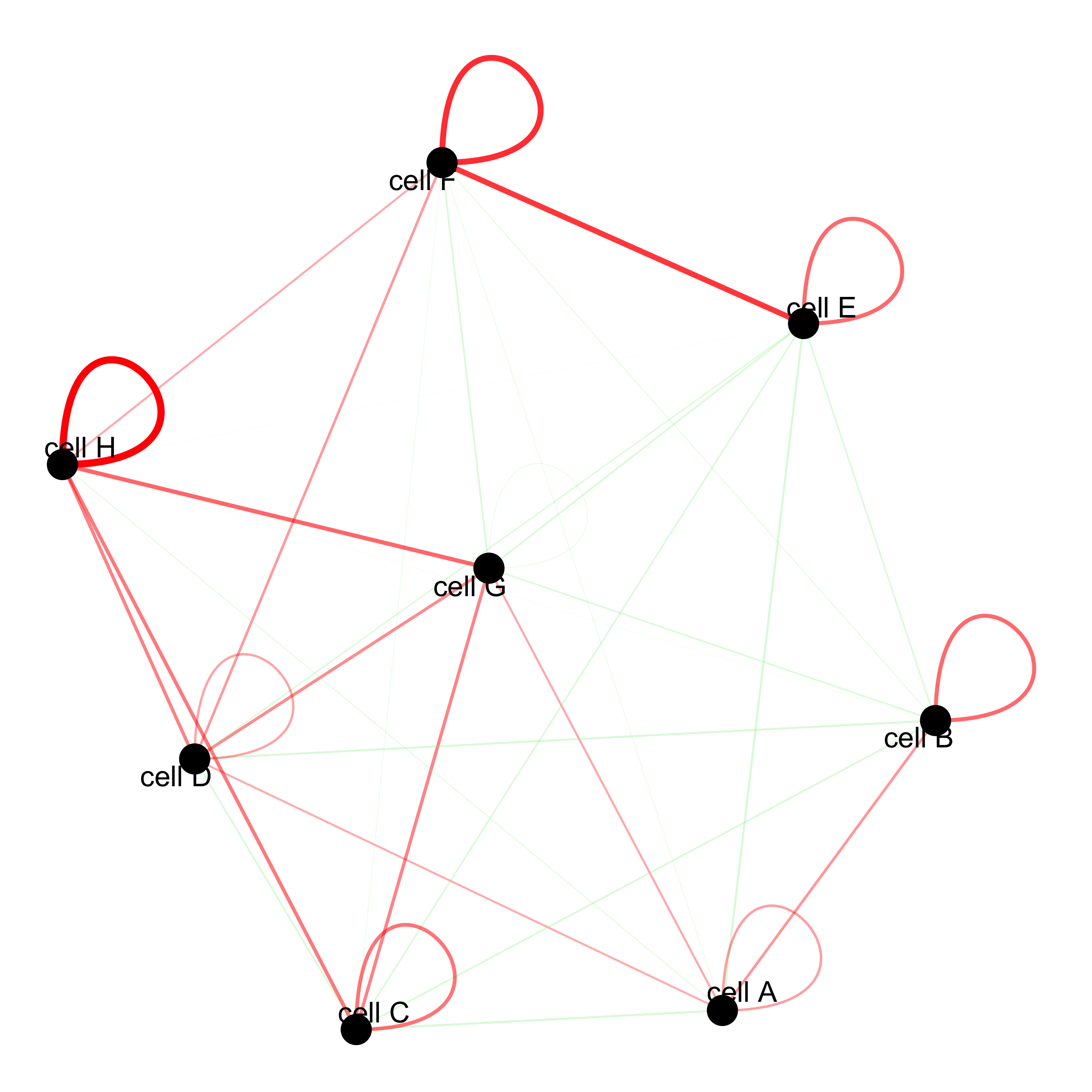
visualization of specific cell types
# Option 1 spec_interaction = "cell D--cell F" cellProximitySpatPlot2D(gobject = seqfish_mini, interaction_name = spec_interaction, show_network = T, cluster_column = 'cell_types', cell_color = 'cell_types', cell_color_code = c('cell D' = 'lightblue', 'cell F' = 'red'), point_size_select = 4, point_size_other = 2)

# Option 2: create additional metadata seqfish_mini = addCellIntMetadata(seqfish_mini, spatial_network = 'Delaunay_network', cluster_column = 'cell_types', cell_interaction = spec_interaction, name = 'D_F_interactions') spatPlot(seqfish_mini, cell_color = 'D_F_interactions', legend_symbol_size = 3, select_cell_groups = c('other_cell D', 'other_cell F', 'select_cell D', 'select_cell F'))
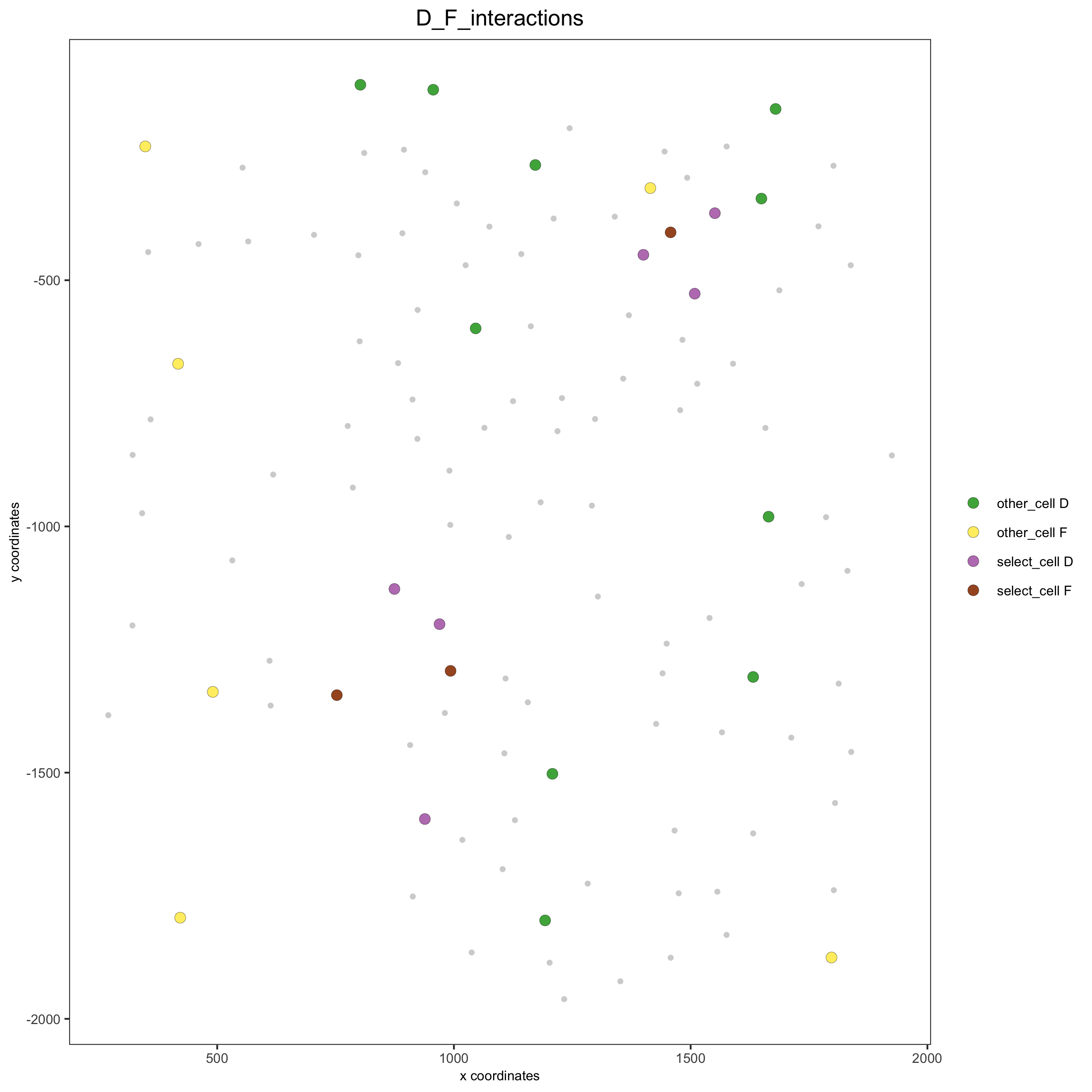
13. cell neighborhood: interaction changed genes
## select top 25th highest expressing genes gene_metadata = fDataDT(seqfish_mini) plot(gene_metadata$nr_cells, gene_metadata$mean_expr) plot(gene_metadata$nr_cells, gene_metadata$mean_expr_det) quantile(gene_metadata$mean_expr_det) high_expressed_genes = gene_metadata[mean_expr_det > 4]$gene_ID ## identify genes that are associated with proximity to other cell types ICGscoresHighGenes = findICG(gobject = seqfish_mini, selected_genes = high_expressed_genes, spatial_network_name = 'Delaunay_network', cluster_column = 'cell_types', diff_test = 'permutation', adjust_method = 'fdr', nr_permutations = 500, do_parallel = T, cores = 2) ## visualize all genes plotCellProximityGenes(seqfish_mini, cpgObject = ICGscoresHighGenes, method = 'dotplot')
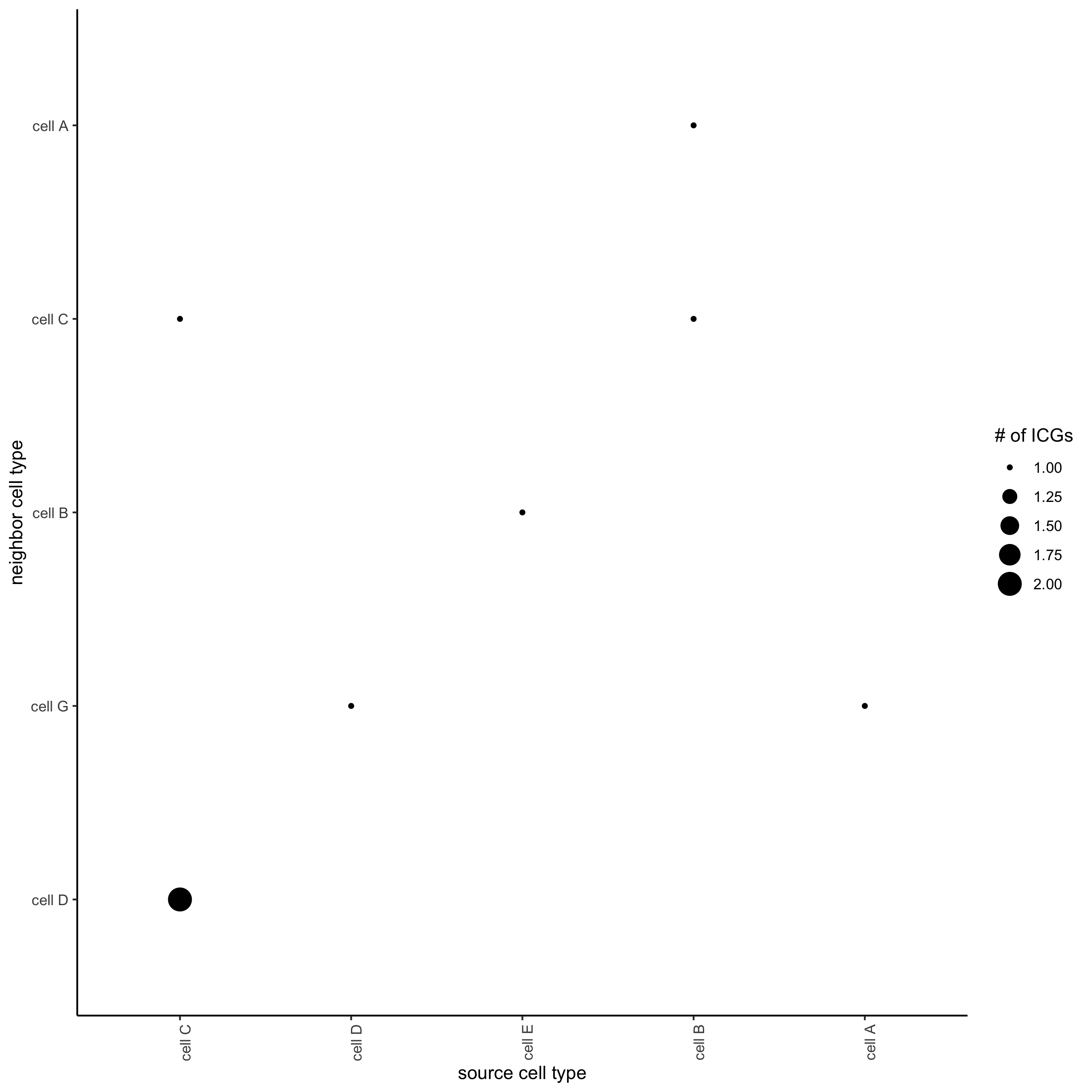
## filter genes ICGscoresFilt = filterICG(ICGscoresHighGenes, min_cells = 2, min_int_cells = 2, min_fdr = 0.1, min_spat_diff = 0.1, min_log2_fc = 0.1, min_zscore = 1) ## visualize subset of interaction changed genes (ICGs) ICG_genes = c('Cpne2', 'Scg3', 'Cmtm3', 'Cplx1', 'Lingo1') ICG_genes_types = c('cell E', 'cell D', 'cell D', 'cell G', 'cell E') names(ICG_genes) = ICG_genes_types plotICG(gobject = seqfish_mini, cpgObject = ICGscoresHighGenes, source_type = 'cell A', source_markers = c('Csf1r', 'Laptm5'), ICG_genes = ICG_genes)
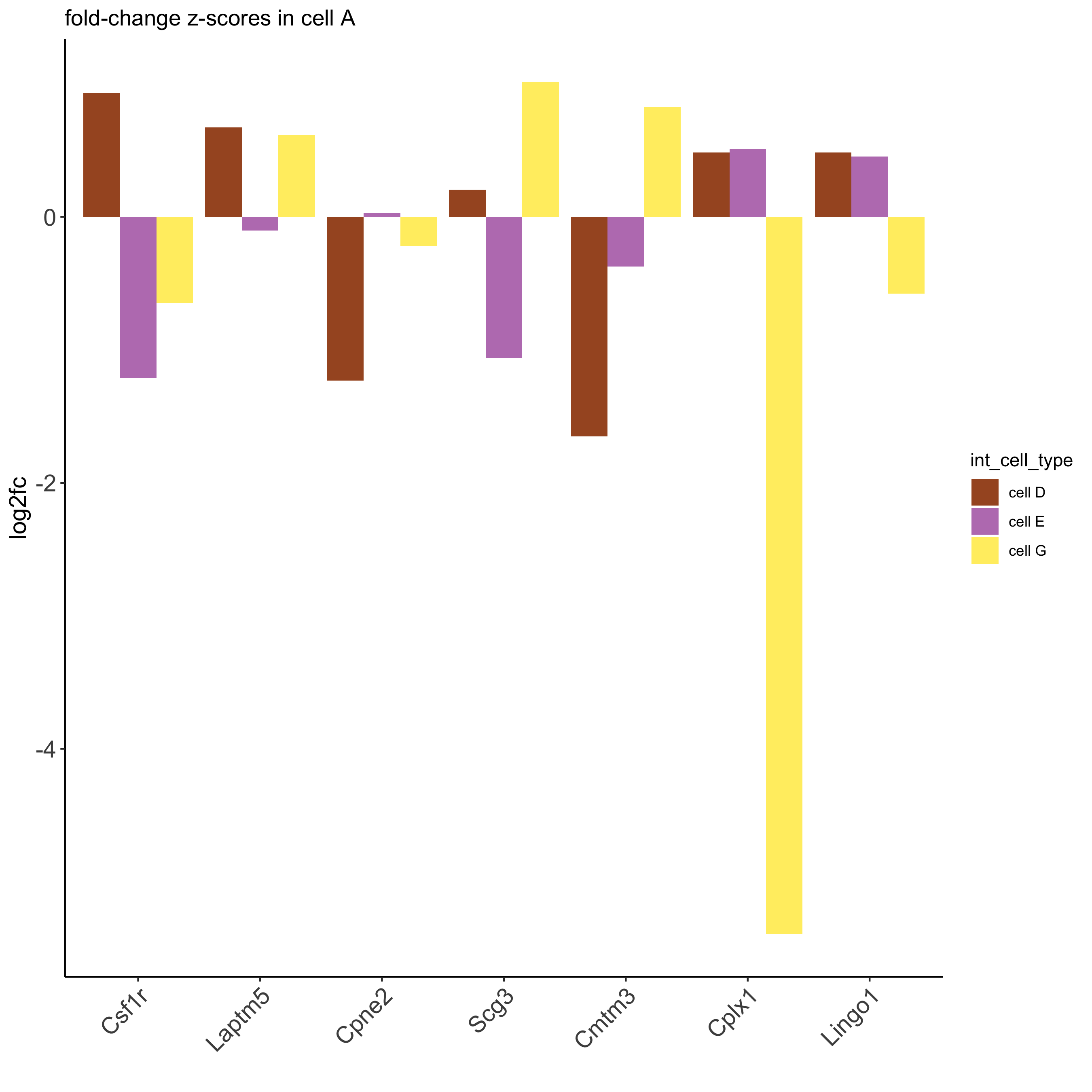
14. cell neighborhood: ligand-receptor cell-cell communication
LR_data = data.table::fread(system.file("extdata", "mouse_ligand_receptors.txt", package = 'Giotto')) LR_data[, ligand_det := ifelse(mouseLigand %in% seqfish_mini@gene_ID, T, F)] LR_data[, receptor_det := ifelse(mouseReceptor %in% seqfish_mini@gene_ID, T, F)] LR_data_det = LR_data[ligand_det == T & receptor_det == T] select_ligands = LR_data_det$mouseLigand select_receptors = LR_data_det$mouseReceptor ## get statistical significance of gene pair expression changes based on expression ## expr_only_scores = exprCellCellcom(gobject = seqfish_mini, cluster_column = 'cell_types', random_iter = 500, gene_set_1 = select_ligands, gene_set_2 = select_receptors) ## get statistical significance of gene pair expression changes upon cell-cell interaction spatial_all_scores = spatCellCellcom(seqfish_mini, spatial_network_name = 'Delaunay_network', cluster_column = 'cell_types', random_iter = 500, gene_set_1 = select_ligands, gene_set_2 = select_receptors, adjust_method = 'fdr', do_parallel = T, cores = 4, verbose = 'none') ## * plot communication scores #### ## select top LR ## selected_spat = spatial_all_scores[p.adj <= 0.5 & abs(log2fc) > 0.1 & lig_nr >= 2 & rec_nr >= 2] data.table::setorder(selected_spat, -PI) top_LR_ints = unique(selected_spat[order(-abs(PI))]$LR_comb)[1:33] top_LR_cell_ints = unique(selected_spat[order(-abs(PI))]$LR_cell_comb)[1:33] plotCCcomHeatmap(gobject = seqfish_mini, comScores = spatial_all_scores, selected_LR = top_LR_ints, selected_cell_LR = top_LR_cell_ints, show = 'LR_expr')
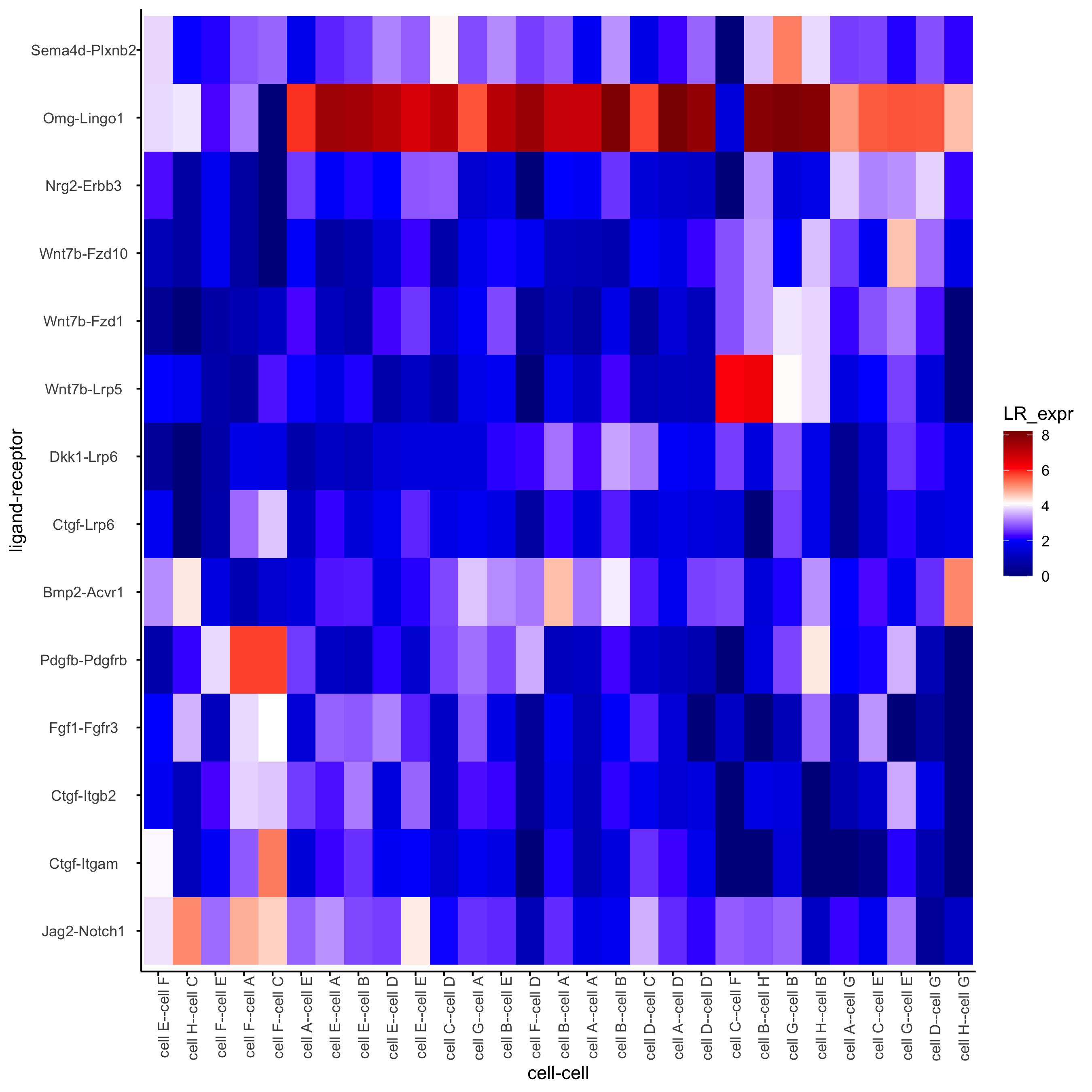
plotCCcomDotplot(gobject = seqfish_mini, comScores = spatial_all_scores, selected_LR = top_LR_ints, selected_cell_LR = top_LR_cell_ints, cluster_on = 'PI')
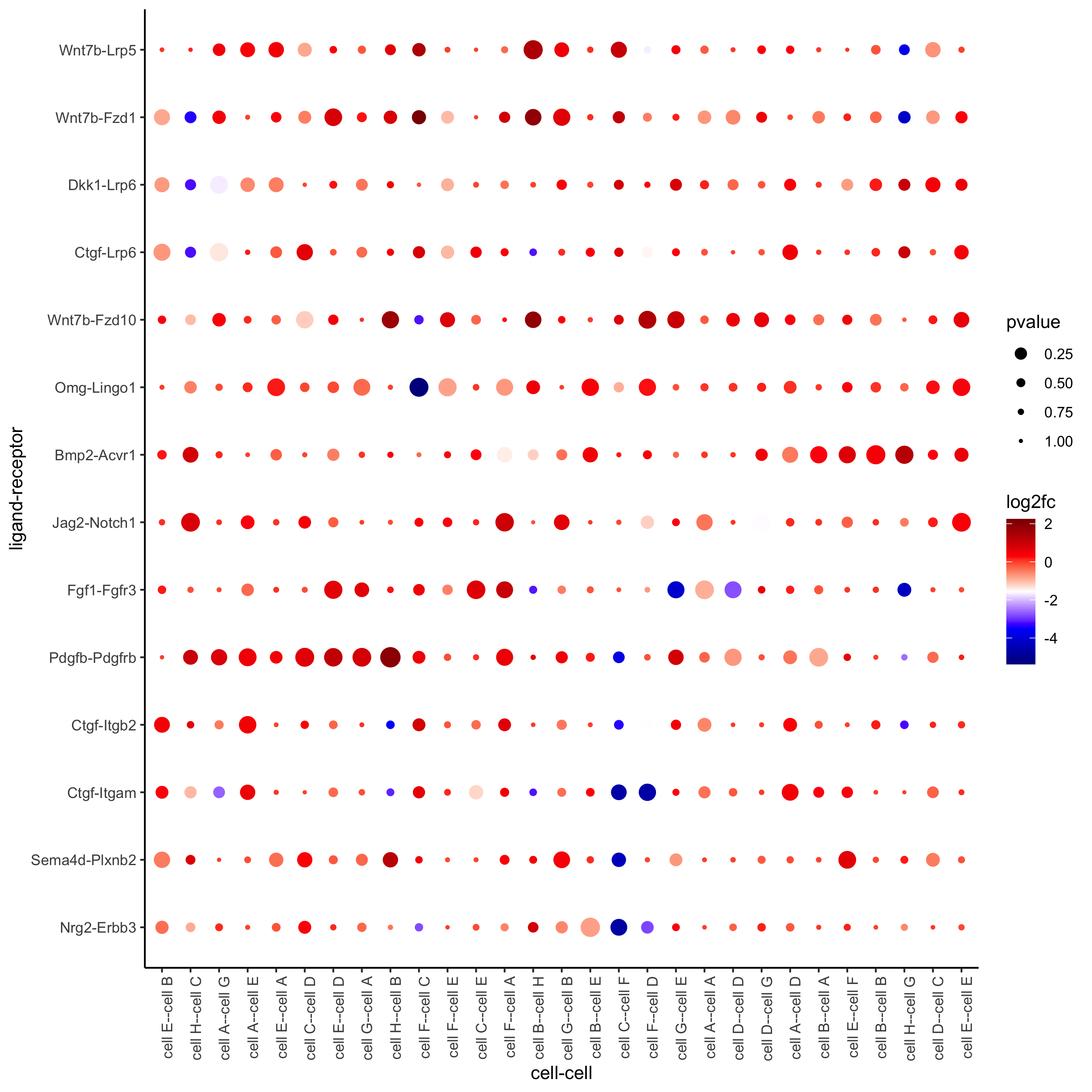
## * spatial vs rank #### comb_comm = combCCcom(spatialCC = spatial_all_scores, exprCC = expr_only_scores) # top differential activity levels for ligand receptor pairs plotRankSpatvsExpr(gobject = seqfish_mini, comb_comm, expr_rnk_column = 'exprPI_rnk', spat_rnk_column = 'spatPI_rnk', midpoint = 10)
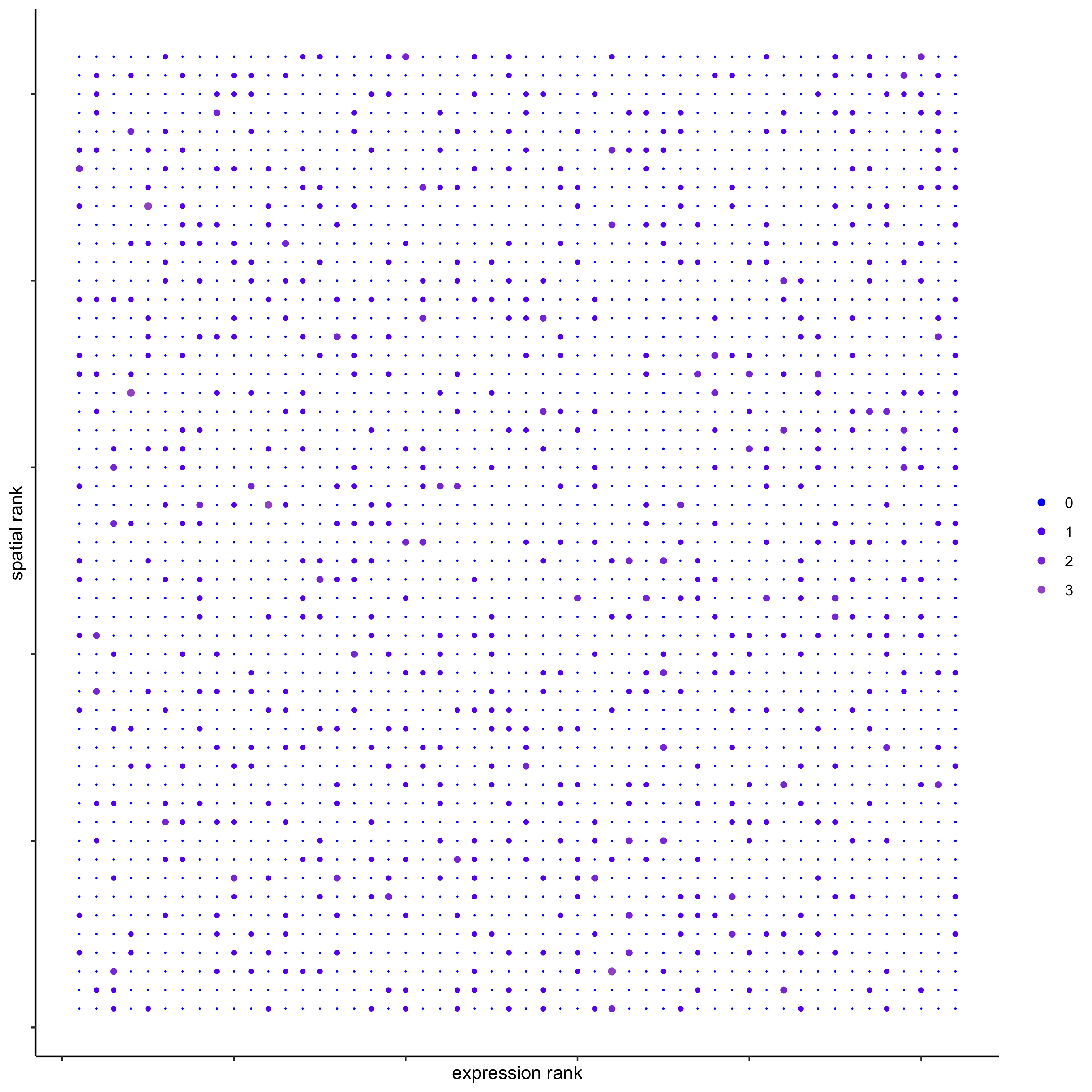
## * recovery #### ## predict maximum differential activity plotRecovery(gobject = seqfish_mini, comb_comm, expr_rnk_column = 'exprPI_rnk', spat_rnk_column = 'spatPI_rnk', ground_truth = 'spatial')
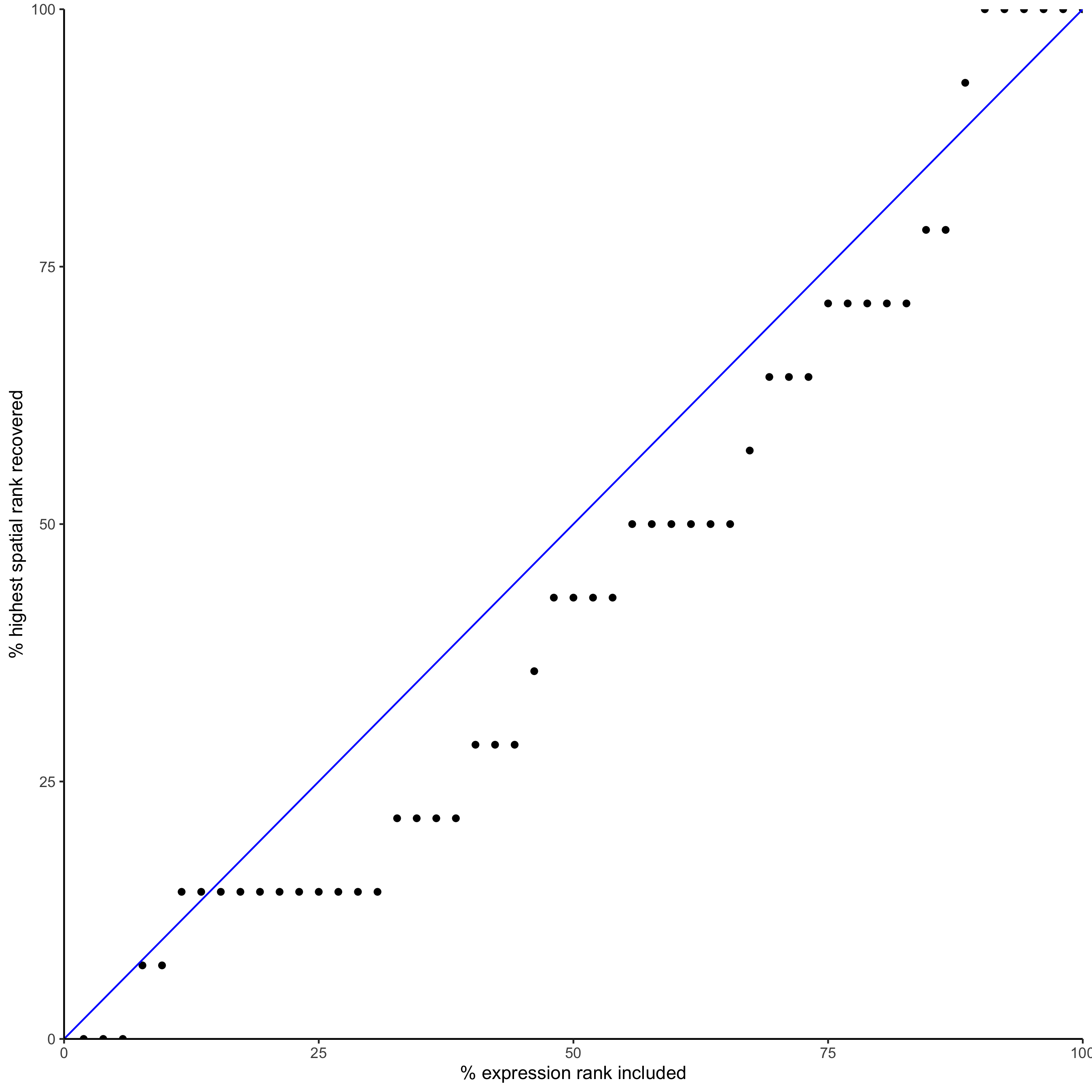
15. export Giotto Analyzer to Viewer
viewer_folder = paste0(temp_dir, '/', 'Mouse_cortex_viewer') # select annotations, reductions and expression values to view in Giotto Viewer exportGiottoViewer(gobject = seqfish_mini, output_directory = viewer_folder, factor_annotations = c('cell_types', 'leiden_clus', 'HMRF_k9_b.28'), numeric_annotations = 'total_expr', dim_reductions = c('umap'), dim_reduction_names = c('umap'), expression_values = 'scaled', expression_rounding = 3, overwrite_dir = T)